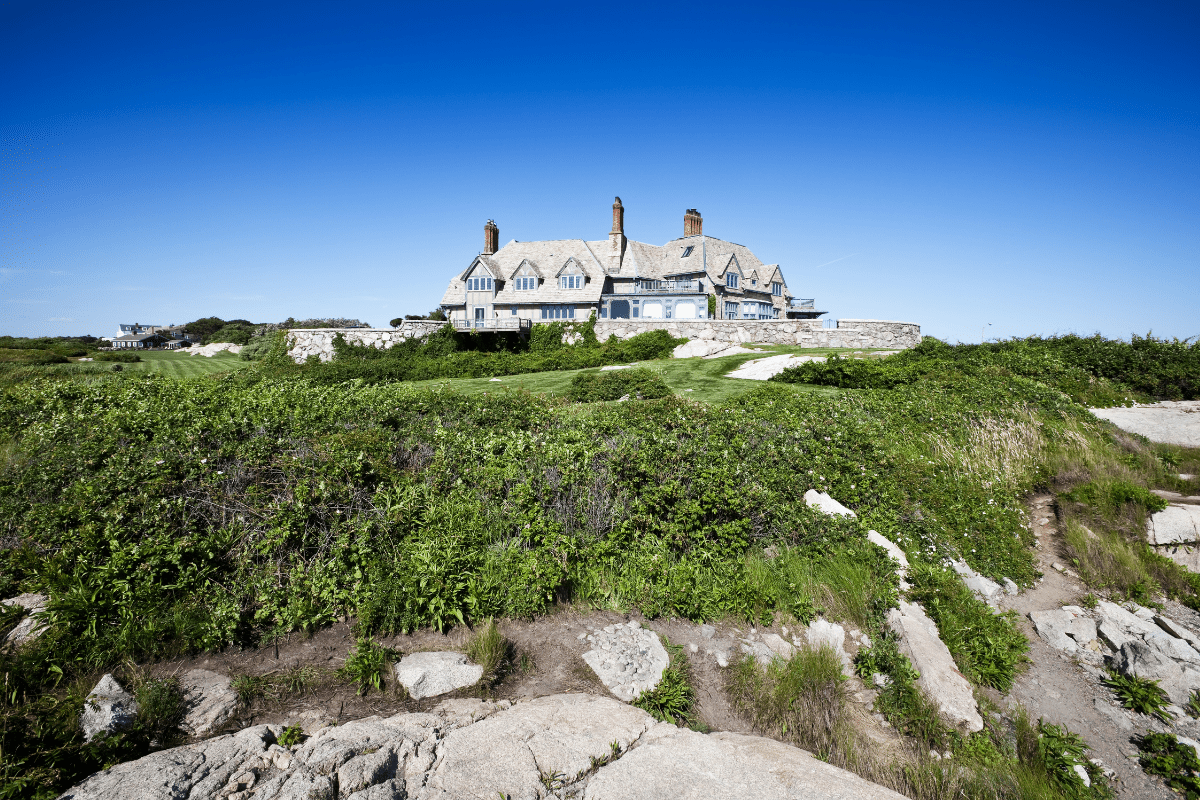Rhode Island packs 400 years of American history into just 1,214 square miles, making it the most historically dense state in the nation. From Newport mansions that cost more than some countries' GDP to the humble church where religious freedom was born, these sites tell the story of America's evolution from colonial experiment to industrial powerhouse to Gilded Age excess.
The Newport Mansions: When summer cottages cost more than small countries
Let's start with the heavy hitters that draw over a million visitors yearly to gawk at how the other 0.001% lived during the Gilded Age.
The Breakers leads the pack
The Breakers isn't just a mansion; it's 70 rooms and 138,300 square feet of "we have too much money" architecture. Built for $7 million in the 1890s (that's $215 million in today's money, if you're keeping track), Cornelius Vanderbilt II's summer "cottage" makes most people's actual houses look like the pool house. After his first mansion burned down in 1892, Vanderbilt basically said "never again" and went full fireproof with masonry walls, steel trusses, and even stuck the boiler underground beneath the front lawn because apparently fire safety was the one thing money could buy.
The current admission runs $32 for general access, and yes, you need timed tickets because nearly 300,000 people visit annually. Here's the exciting news though: in 2024, they opened the third floor to the public for the first time in 129 years. You can now snoop around the Vanderbilt family's private quarters through specialized preservation tours at noon and 2pm daily. Want to go full explorer mode? The "Beneath The Breakers" tour takes you through underground tunnels and the boiler room, where you'll learn this was one of America's first fully electrified homes. Those 27 fireplaces? Mostly for show, because when you have electricity and central heating, actual fires are so last century.
Marble House: The most expensive birthday present ever
If you think your spouse goes overboard for birthdays, consider that William Vanderbilt gave his wife Alva a 50-room mansion for her 39th birthday in 1892. The kicker? Of the $11 million construction cost, $7 million went to marble alone. That's 500,000 cubic feet of marble in various colors, because apparently one color would have been too pedestrian.
Plot twist: after their 1895 divorce, Alva kept the house (obviously) and later used the Chinese Tea House for women's suffrage rallies. Talk about making lemonade from very expensive lemons. These days, you can actually have afternoon tea there yourself through a partnership with Stoneacre Restaurants, though you'll need to pay mansion admission on top of your finger sandwich tab.
The Elms and its behind-the-scenes drama
The Elms showcases what happens when you combine unlimited funds with cutting-edge technology. This place had one of America's first electrical ice makers and was among the first homes wired for electricity without any backup system… which was either supremely confident or slightly insane for the time.
The real treat here is the Servant Life Tour (10am, noon, and 2pm daily), which takes you up 120 stairs through the areas where 36 servants kept this whole operation running. You'll see basement kitchens, coal cellars, laundry rooms, and third-floor staff quarters that make you grateful for modern labor laws. Fun fact: the recently restored Conservatory fountain is working for the first time in over 20 years after a $205,000 restoration in 2024. That's more than most people's entire house renovation budget… for a fountain.
When to brave the mansion crowds
Summer (June through August) is when the majority of those million-plus annual visitors descend on Newport, so expect crowds and book ahead. The holiday season transforms four mansions from late November through January 1, with "Sparkling Lights at The Breakers" alone attracting over 30,000 visitors. In 2024, Château-sur-Mer joined the holiday fun for the first time in 20 years, presumably because even century-old mansions need to stay relevant.
Spring and fall offer the sweet spot: decent weather without the summer mobs. April's Daffodil Days features 22,000 daffodils and 37,000 tulips at Green Animals Topiary Garden, while October brings fall foliage that makes these already photogenic estates look even more Instagram-worthy.
Fort Adams: Where military history meets summer festivals
Fort Adams State Park brilliantly combines free recreational access with fascinating military history, assuming you're willing to pay for the good stuff.
The park grounds are free (bless), but the guided fortress tours cost $20 for adults and are worth every penny. You'll explore America's largest coastal fortification, built between 1824 and 1857 under the direction of Simon Bernard, who previously worked for Napoleon. The fort could house 2,400 troops across three tiers of gun batteries, which seems like overkill until you remember how paranoid everyone was about naval invasions back then.
Want the VIP treatment? The "Beyond the Walls" golf cart tour ($30) explores outer defenses and President Eisenhower's Summer White House. And if you're into spooky stuff, four-hour paranormal investigations run $40. The fort was featured on Ghost Hunters in 2008, with reports of disembodied voices and phantom footsteps from soldiers who died during its military service through 1965. July 2025 brought the opening of underground listening tunnels to self-guided tours, because apparently regular tunnels weren't creepy enough.
The fort also hosts Newport's legendary summer festivals:
- Newport Jazz Festival (August 1-3)
- Folk Festival (July 25-27)
- Combined attendance exceeding 100,000
- Major economic impact for the region
- Excellent people watching opportunities
Providence: Where religious freedom was born (and still thrives)
Providence deserves more credit for basically inventing the concept of religious tolerance in America, even if it doesn't have quite the same mansion-y glamour as Newport.
Roger Williams National Memorial
This free 4.5-acre urban park marks where Roger Williams established Providence in 1636 as a "shelter for persons distressed of conscience." That's 17th-century speak for "come here if you're tired of being told how to worship." The visitor center occupies the restored 1736 Antram-Gray House and opens Thursday through Sunday with seasonal variations. The 15-minute introductory video explains how Williams' radical ideas influenced the First Amendment, making this arguably one of the most important spots in American history that most people have never heard of.
First Baptist Church in America
Founded by Williams in 1638, this congregation can legitimately claim to be the first of its kind in America. The current Georgian-style building dates from 1774-1775, designed by Joseph Brown who was apparently an astronomer in his spare time. The steeple went up in just 3.5 days and exactly replicates an unbuilt design for London's St. Martin-in-the-Fields, because even colonial Americans loved a good architectural knockoff.
Tours run Tuesday and Thursday at noon, 12:30, 1:00, and 1:30pm by donation, with materials available in 12 languages. Brown University has held commencements here since 1776, with graduation processions still marching from campus to church each spring, proving that some traditions are worth keeping even if they involve a lot of walking in uncomfortable shoes.
Providence Athenaeum
One of America's oldest independent libraries operates on a refreshingly democratic pay-what-you-can model with a suggested $5 donation. The 1838 Greek Revival building holds nearly 200,000 items and witnessed Edgar Allan Poe's ill-fated romance with Sarah Helen Whitman, who broke their engagement here on December 23, 1848. Apparently even Gothic romance writers can't escape awkward breakups in libraries.
What makes this place special beyond the Poe drama? They're pet-friendly, with treats at the circulation desk for well-behaved dogs. Free guided tours run Wednesdays at 10:30am and Saturdays at 2pm, while the self-guided "Raven Tour" takes about 20 minutes if you don't get distracted by actually reading books.
Benefit Street's Mile of History
This isn't just any historic street… it's the most impressive concentration of original Colonial homes in America, spanning 1.2 miles of preserved architecture that survived 1950s urban renewal because locals basically chained themselves to the buildings (not literally, but almost).
The John Brown House Museum, which John Quincy Adams called "the most magnificent and elegant private mansion on this continent," offers $15 tours Tuesday through Saturday. Down the street, the Stephen Hopkins House (yes, that Hopkins who signed the Declaration of Independence) opens Wednesdays 11am-2pm and Saturdays 10am-4pm, staying open until 10pm on WaterFire nights when Providence turns into a mystical fire-and-water art installation.
Slater Mill: Where American manufacturing was born
Slater Mill Historic Site revolutionized American industry as the nation's first water-powered cotton spinning mill in 1793. The best part? Admission became free in 2021 when the National Park Service took over, proving that sometimes government intervention actually makes things better.
Samuel Slater earned the nickname "Slater the Traitor" in England for bringing industrial secrets to America, which seems harsh but fair. He partnered with Moses Brown to establish the mill that operated until 1895, employing children as young as four to work dangerous machinery. The 30-45 minute guided tours (10:30am, 12:30pm, and 2:30pm from spring through fall) showcase 24 textile machines dating from 1775 to 1922, along with some appropriately dark history about child labor that makes you appreciate OSHA.
These days, the mill offers Junior Ranger badges and seasonal fiber art classes, while the annual Knitting Weekend draws up to 2,000 visitors from across New England. The paranormal activity reports (screams of children crushed in accidents) add an appropriately creepy dimension to what's already a pretty dark chapter in American labor history.
Block Island Southeast Lighthouse: The one they moved
Here's a preservation story that sounds made up but isn't: when erosion reduced this lighthouse's distance from the cliff edge to just 55 feet, engineers moved the entire 2,000-ton structure 300 feet inland. The 1993 relocation cost $2 million and required three Acts of Congress, because apparently you can't just scoot a lighthouse over without federal permission.
The Gothic Revival tower, built 1874-1875 for $75,000, now charges $20 for combined museum and tower tours. Fair warning: this involves 136 steps plus a seven-foot ladder requiring both hands to reach the top catwalk. If you're afraid of heights or ladders or ladder-height combinations, maybe stick to the museum in the restored keeper's quarters, which opened summer 2021.
The surrounding waters earned Block Island the nickname "Stumbling Block of New England" with 180 documented shipwrecks between the 1660s and 1865. Getting there requires a ferry from Point Judith (year-round service, 55 minutes on traditional ferries for $12-21, or 30 minutes on high-speed vessels May through October). The lighthouse sits 1.8 miles from the ferry landing, and while the grounds stay open sunrise to sunset year-round, the museum and tower tours are seasonal.
Making the most of your historic Rhode Island adventure
Recent tourism data shows Rhode Island hit record visitor numbers in 2023, with historic sites driving much of that $8.3 billion economic impact. The state's 86,612 tourism jobs depend heavily on these attractions, which explains why preservation efforts have ramped up recently.
Technology has transformed the visitor experience too. Virtual 3D tours launched during COVID remain available for armchair travelers, while HBO's "The Gilded Age" filming at the mansions created location tours that sell out at $250 per ticket faster than you can say "Downton Abbey."
Recent preservation wins worth noting:
- Isaac Bell House: $3.3 million restoration
- Rosecliff: $7.4 million Historic Preservation Award winner
- The Breakers: 13 masonry chimneys repaired
- Fort Adams: $2 million ongoing restoration
The bottom line? Rhode Island's historic sites offer everything from obscene wealth to industrial innovation to religious freedom, all within America's tiniest state. Whether you're into gilt-covered everything, military fortifications, or the birthplace of American manufacturing (child labor and all), there's something here to make you grateful you live in the present while thoroughly enjoying a peek at the past. Just remember to book those Breakers tickets in advance, bring comfortable shoes for all those mansion stairs, and maybe skip the ladder at the lighthouse if you've had one too many Rhode Island coffees (milk, not cream, and definitely not regular).





